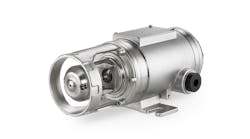There are times that an alarm can’t be removed or an alarm setpoint can’t be changed to resolve a noisy process signal causing a chattering alarm. When this occurs, there are techniques that can be applied to the process signal or alarm to reduce alarm chattering. It’s important to understand the effect each method will have on the alarm or process measurement prior to implementing it. This article discusses each technique and the results when applied.
Understand the issue
These techniques should never be applied blindly because they’ll likely not have the positive impact that was desired and could cause measurement issues or mask an alarm or delay a response by the operator. Before considering which method to apply, the reason(s) for false positive alarms must be determined for all states of the operation (startup, trip, normal, etc.). Solving the alarm issue for one operating condition may mask an alarm that’s real in another condition. Once the issues have been defined, then consider which technique will solve most of the false alarms.
A frequent mistake is increasing the masking effect because the applied technique did not resolve most of the false positive alarms. An example of this would be to increase the delay time from five seconds to five minutes. This will reduce more false positive alarms, but can lead to masking real alarms by delaying activation of the alarm until the five-minute delay has expired. The correct solution may be to apply a different technique or apply more than one technique to get the desired result of reduced false-positive alarms and minimized masking of real alarms.
Filtering smoothes measurement
Normally, filtering is applied to reduce control action on a noisy process signal to improve the control of the process. Filtering can also have a positive impact on reducing false alarms. Filtering minimizes a noisy process signal by smoothing the measurement, which reduces the false positive alarms. Applied directly to the measurement, filtering will affect control action on a closed-loop point, which must be considered before adding it.
Figure 1 shows that the filtered signal (output) doesn’t exceed the high alarm setpoint, while the unfiltered signal (input) does exceed the high alarm limit. On the first incident, the unfiltered and filtered signals cross the low alarm setpoint, but later, the filtered signal doesn’t cross the low alarm setpoint when the unfiltered signal does cross.
[sidebar id =2]
Advantages of filtering are:
- Reduces false positive alarms
- Alarm delay activation is minimized on fast changing process
- Reduces alarms when noisy process is operating close to the alarm setpoint
Disadvantages of filtering are:
- Delays alarm activation on slow moving process
- Can hide an alarm when the process is operating around the alarm setpoint
- Has minimal effect on very noisy processes
- Can negatively impact control performance
Deadband adds alarm hysteresis
Alarm deadband is the change required in the process signal to either activate the alarm or return the alarm to normal (Figure 2). Some computer control systems allow deadband to be applied to either the activation or return of the alarm, while others allow it only on the return of the alarm. Deadband is typically applied by entering a percentage of the measurement, which can lead to latching of the alarm when the measurement range is large.
For example, if the flow range is 100,000 and a 2% deadband is applied, the alarm will not clear until the measurement is 2,000 below the alarm limit. Using these numbers for an example where the process normally runs at 68,000 and the alarm limit is set to 69,000, once the alarm is activated, it will not return to normal until the process goes below 67,000, which is below the operating setpoint and the process measurement. In this example, the alarm will never clear and the operator will never get another alarm when the process rises above the alarm limit. Here, if the computer control system allows, it would be best to set an absolute value for the deadband.
[sidebar id =3]
Deadband advantages are:
- Reduces false positive alarms
- Immediate activation of the alarm when deadband is only applied to the return to normal
- Typically the easiest to apply or configure in a computer control system
Deadband disadvantages are:
- Percentage applied deadband could apply a setting too large, latching the alarm on or off
- False positive alarm activation holds the alarm high, which could cause an operator to miss a real alarm if the deadband level isn’t cleared before the next activation of the alarm
- Slow operator response on a real alarm when the deadband is applied to activation of the alarm, and not on the return to normal
Time delays
A time delay can be applied to delay when the alarm is activated (on-delay) or when the alarm has cleared (off-delay). The on-delay is used to avoid unnecessary alarms when a signal temporarily overshoots its limit, thus preventing the alarm from being activated until the signal remains in the alarm state continuously for the specified length of time of the delay. The off-delay is used to reduce chattering alarms by holding the alarm active the specific length of time of the delay after the process has dropped below the alarm limit.
The on-delay will delay activation of the alarm by the amount of time entered. If the process returns below the alarm limit prior to the alarm being activated, the timer will be reset. Care must be taken when using a time delay on since a real alarm activation will be delayed by the time delay setting. Time on-delay should be used sparingly and for slow moving processes. Figure 3 shows an oscillating process (blue) that would give 11 alarms (orange) where the time delay on (purple) indicates only one alarm. In this demonstration, the on-delay would reduce the false positive alarms by 10.
[sidebar id =4]
Advantage of on-delay:
- Reduces false positive alarms when the process is changing quickly
Disadvantages of on-delay:
- Delays activation of a real alarm to the operator, which delays the operator’s response time to the alarm
- Masks real alarms when the process is noisy and operating at the alarm limit
The off-delay will delay clearing the alarm once the measurement has returned to normal by the delay time entered. When the process exceeds the alarm limit, the alarm will be activated, but will not clear until the process stays below or above the alarm limit by the amount of the delay time setting. This will not resolve the activation of a false alarm, but will reduce the number of alarm activations for a noisy measurement. The advantage of an off-delay is immediate notification of a real alarm to the operator. Figure 4 shows an oscillating process (blue) that would give 11 alarms (orange) where the time delay off (green) indicates only one alarm. In this demonstration, the off-delay would reduce the false positive alarms by 10, but create a standing alarm during false alarm conditions, and may not be reacted to when the process does enter a real alarm condition.
Advantages of off-delay:
- Immediate activation of alarm
- Reduces false positive alarms on a noisy signal
Disadvantages of off-delay:
- Initial false alarm may hide a real alarm because the alarm has not returned to normal after the false alarm
- Can create a standing alarm issue because the alarm never resets
Select carefully
It’s important to first determine what the cause of the chattering alarm is and try to solve it without applying one of these reduction techniques. The first choice is always solving the issue at the source (e.g., repair the instrument, adjust the alarm setpoint, adjust the process setpoint, etc). When fixing the problem at the source isn’t possible, then determine which technique will minimize the risk of missing a real alarm, but reduce the number of false positive alarms in all operating conditions. Keep in mind that the solution may require the use of more than one of these techniques (e.g., filtering and on-delay, deadband and off-delay) to minimize masking of real alarms and reduce false positive alarms.
[sidebar id =5]
Latest from Alarm Management

Leaders relevant to this article:


